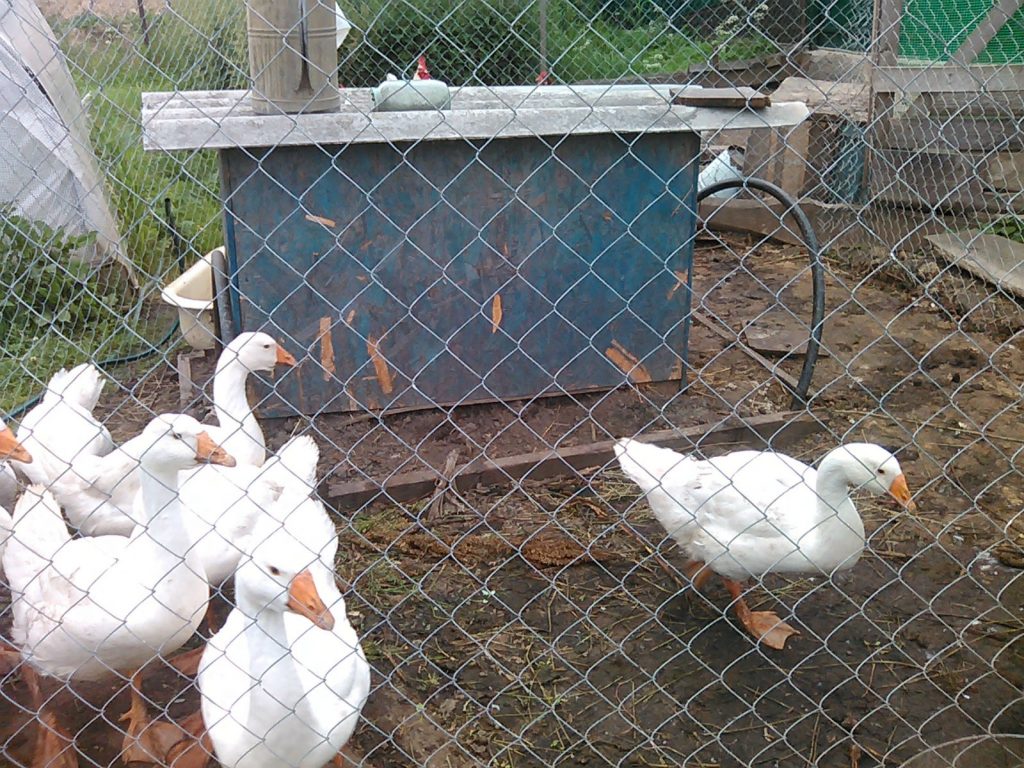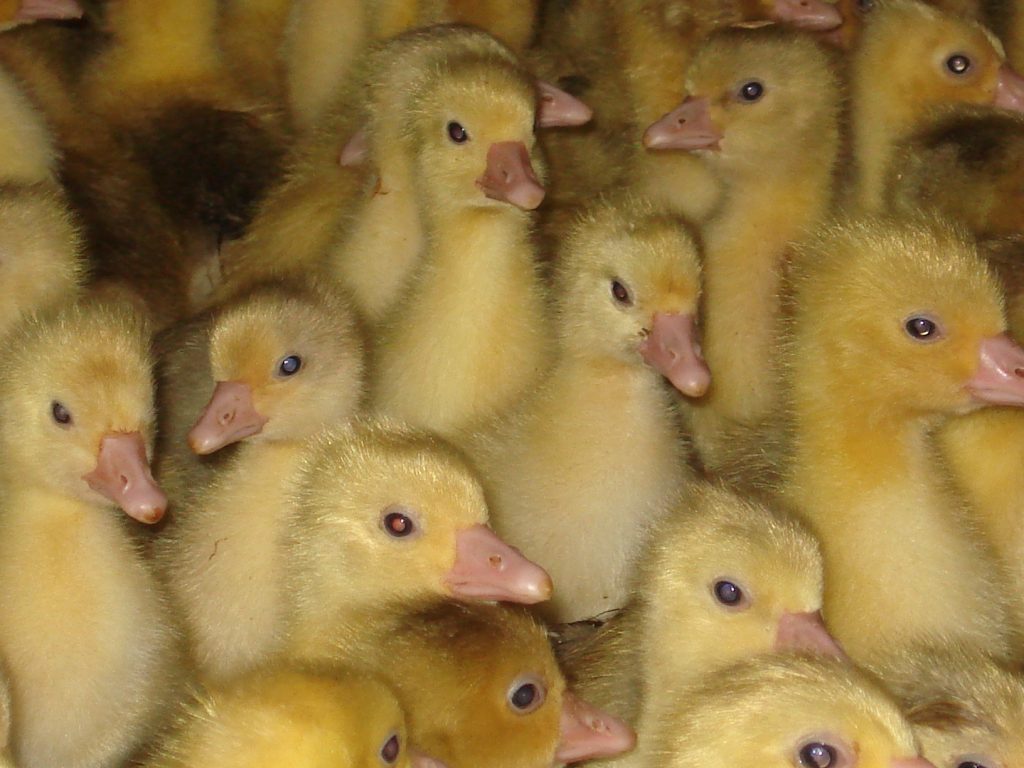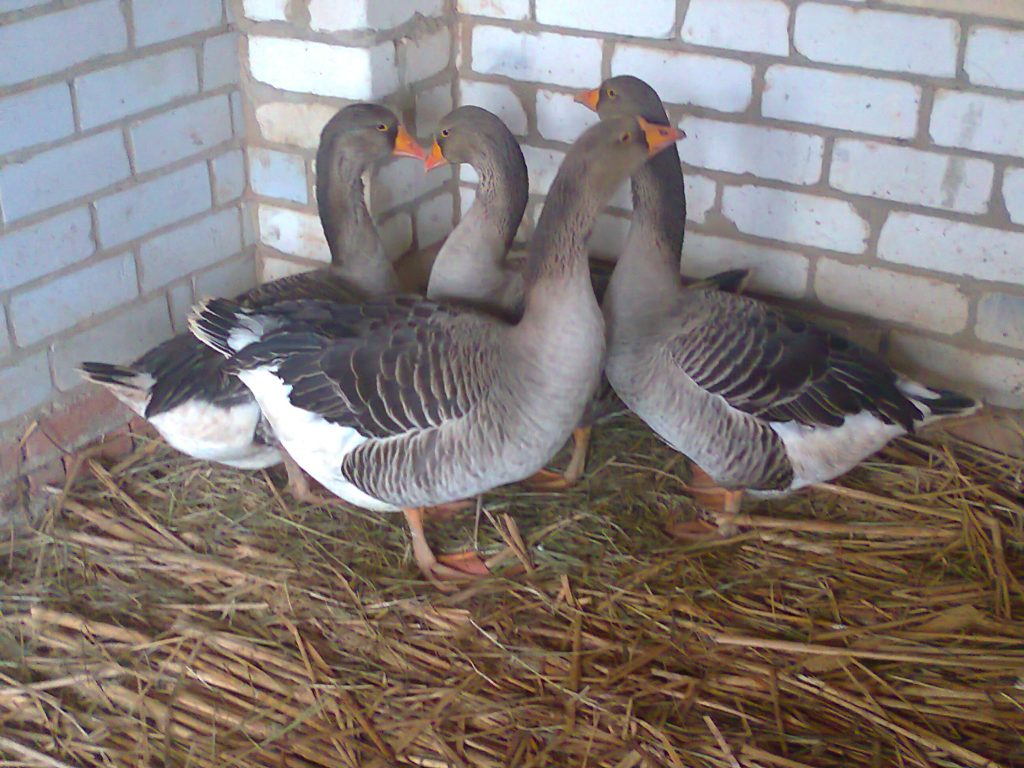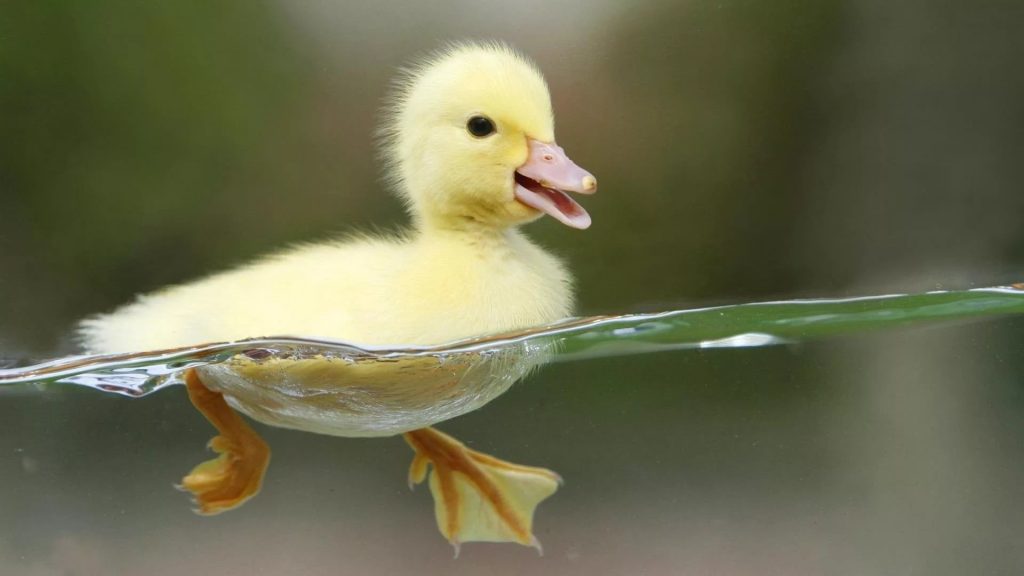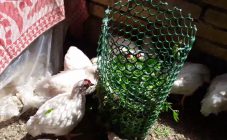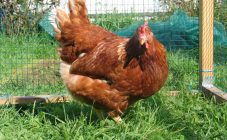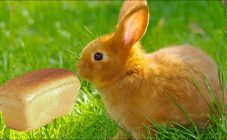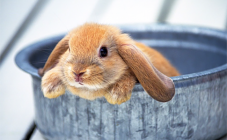Content:
Among all farm birds, geese are a very popular breed. Having tamed geese about 3,000 years ago, mankind received an influx of tasty and nutritious meat, liver and feathers. The distribution of this species in rural conditions and on an industrial scale is explained by the high growth rate. Their live weight in the first couple of months of life increases almost 40 times. 70-80% of the total ration is the grass they get for the walk. This quality allows farmers to save money on the purchase or preparation of feed. Birds have well-developed adaptive properties that allow them to adapt to any conditions of keeping. However, geese love to swim, for which it is necessary to provide access to the water.
To produce a steady influx of goslings at home is a laborious and painstaking process. Low egg production imposes a great responsibility. To obtain a constant increase in healthy, strong livestock, some prerequisites must be observed.
Keeping goslings in the house
Regardless of the method of obtaining goslings, whether it is incubating eggs or incubating their geese, in the first days, special attention should be paid to the conditions of keeping the young.
The house itself should be lined with materials that can be easily cleaned and disinfected. It is imperative to equip it with ventilation systems, lighting and heating devices.
Before settling in, the goose bed must be thoroughly cleaned and disinfected. It is safe to use solutions of bleach or soda for such purposes, after which all surfaces must be thoroughly rinsed with water.
If other birds were raised in the house before the goslings, all heat-resistant structures, such as feeders and drinkers, can be ignited in a flame. As a feed, it is better to use a mash of crushed peas, barley, bran and mineral feed.
It is necessary to feed daily goslings every 3-4 hours, gradually reducing the number of feedings by the end of the first week to 4 times a day. At the age of 2-3 weeks, you can replace up to 30% of dry food with chopped root crops and boiled potatoes. Feeding a commercial compound feed saves time for distributing feed and simplifies the calculation of the daily allowance.
There should always be containers with gravel, crushed shell, sand and chalk in constant access.
When choosing feeders, the choice should be stopped on structures with sides, 1.5-2 cm in height. For only hatched goslings, it is better to install feeders next to a heat source. From the second day of life, the feed trays can be raised above the floor level, this measure will prevent spreading and trampling of the feed. For young goslings, it is better to use a vacuum-operated drinker, purchased or made yourself. When goslings reach 1 month old, adult feeders and trough drinkers can be supplied.
How much goslings can be released per 1 sq. meter of the room? The concentration of the poultry population needs to be regulated. For 1 sq. meter can be populated 8-10 goslings up to 1 month of age, upon reaching 2 months of age in the same area, you can keep only 4 individuals.When reaching adulthood on the same 1 sq. you can leave only 2 geese per meter.
In the event that it is planned to equip the poultry house with an aviary for grazing, the following nuances should be taken into account:
- part of the aviary should be shaded from the scorching sun;
- it is necessary to equip a manhole for access to walking;
- requires regular mowing of the pasture to a grass height of 5-10 cm;
- the approach to the water should be covered with sand;
- there must be a descent to the water.
The first weeks of life for goslings, the level of humidity in the room should not be higher than 65-75%. Excessive indicators, coupled with non-observance of the ventilation regime, promotes the development of pathogenic microorganisms in the litter and contamination of the livestock.
Frequent ventilation is necessary from the first days of life. In the warm season, you can ventilate the room around the clock.
Grown-up goslings tolerate temperature changes better than daily ones. For them, you can gradually lower the background temperature. After reaching 15-30 days, based on the general condition of the chicks, the heating can be removed.
Until the goslings reach the age of one month, daylight hours should be at least 14 hours a day. For active food at night, you can leave a dim light.
Temperature regime for keeping goslings
Unlike adults, who can tolerate temperature drops down to 0 ℃, small goslings give off more heat than they receive in the table of contents of their lives. The temperature for goslings under one month old is undergoing changes. Maintaining the required level will help protect goslings from mortality, contributing to their rapid growth and development.
In the first 10 days of life of goslings, the formation of thermoregulatory mechanisms of the body takes place. The temperature of keeping goslings should be high. In a house where a brood without a goose is inhabited, it is necessary to set a constant temperature level of 28-30 ℃. This condition is mandatory for both cage and open-air housing. From the fourth day on, the background temperature can be gradually reduced. For weekly goslings, the optimum is 25 ℃, from ten days of age - 22 ℃.
Dry bedding is required to keep warm. To do this, it should be updated every couple of days. It is better to maintain the required temperature regime using a lamp equipped with a 200-300 W lamp.
Table diagram of temperature changes for goslings as they grow
| Age, days | Temperature, ℃ |
|---|---|
| 01.03.2018 | 28-30 |
| 04.05.2018 | 25-28 |
| 06.07.2018 | 23-25 |
| 08.10.2018 | 22-24 |
| 01.11.2015 | 20-22 |
| 16-20 | 18-20 |
| 21-65 | 18-20 |
At night, you can use a heating pad or container of hot water wrapped in a cloth as a heating source.
The need for temperature correction can be understood from the behavior of goslings. In suitable conditions, the birds are located close to the feeders, rest on the bedding, not paying special attention to heating devices.
At elevated temperatures, birds open their beaks, breathe faster and look drooping. At this time, individuals often drink a lot and practically do not pay attention to food.
If the temperature is too low, the birds move little or walk with their wings down. As in the case of overheating, refusal of feed and collection of young animals near the heaters is recorded. With a lack of heat, the goslings form groups. With hypothermia, development slows down, and the goslings stop growing.Why is poor room temperature control dangerous? Such temperature fluctuations are dangerous in that when crowding, a crush occurs, and often many individuals die.
Litter on the floor
The floor in the house must be level. Most often, the floor is poured with concrete, since it is easier to clean and disinfect. Almost any material can be laid as a bedding. It can be peat, sawdust, shavings, chopped straw. Before laying the filler, the floor must be sprinkled with lime at the rate of 0.5-1 kg per 1 sq. square meter. The litter needs to be changed frequently because goslings, like duck litter, get wet much faster than chickens or turkeys. Wet litter can trigger the development of pathogenic microflora and suppress the immune system.
In the cold season, it is necessary to lay a bedding for geese, at least 30 cm thick. Such a layer will protect the birds from hypothermia.
Optimal swimming age
At what age can you bathe goslings? The plumage of goslings takes a long period. As a rule, a complete change of down to feathers occurs by 75-80 days from the moment of hatching. During the first 20 days, the goslings are covered with down, in the next 10 days tail feathers begin to appear in the tail.
Goslings manage to fledge before they reach 3.5-4 months of age. During the first month when the goslings fledge, it is important to make sure they do not get wet. During this period, the chicks develop wing feathers.
You can start releasing young growth into fresh air from a week of age. At first, the walk should not exceed 30 minutes. By gradually increasing the time, by two weeks of age the goslings can be left in the fresh air throughout the day. You can leave goslings to spend the night outside when the temperature at night is stable above 10 ℃.
Goslings can swim when a complete change of feather cover occurs. Water training must be done from the age of three weeks. In cold weather, only those chicks whose down cover has been replaced by a real feather, capable of protecting against wetting and hypothermia, can be allowed to the water.
Methods for heating a room with goslings
Heating is the main factor in the development of diurnal goslings. For them, you can remake boxes or boxes, having previously insulated them, equipped with a lid and a lighting system.
Heating lamps or reflectors must be installed in the cover. In the event that the room for keeping the goslings is warm enough, specialized electric brooders can be used.
For example, the BI-12 industrial brooder has the shape of an umbrella. The heating effect is achieved by the presence of infrared lamps in the design. The brooder should be placed on the floor until the chicks are two weeks old. After that, it must be hung from the ceiling.
Imported umbrella brooders can be equipped with lighting lamps and thermostats. The temperature regime is automatically regulated in such models. The farmer needs to set the desired temperature, when lowering below which the device will automatically turn on the heating.
For goslings, the development room must be carefully prepared. It must be equipped with drinking bowls, feeders, heating and lighting systems. House wall and floor material should be easy to clean and disinfect. The floor surface must be flat and must be covered with dry and clean filler.Peat layer, sawdust and straw can play its role. The litter should be replaced as often as possible, as it gets wet much faster in goslings than in other poultry. Dry litter can become a source of colds, fungal infections or infectious diseases in young animals.
Temperature maintenance plays an important role in the development of goslings. Until their own thermoregulation is established, goslings need to maintain a high temperature in the room. As they grow, the background temperature should be reduced to avoid overheating. Lack of heat in the house provokes crowding and death of young animals. In addition, growth and development processes are inhibited.
At what age can goslings swim? When the goslings begin to fledge, there is a gradual change in the light fluff of the chicks. This is a rather lengthy process. At the end of the first month, the formation of tail and flight feathers begins. After completing the plumage process, the goslings can begin to accustom the young to water.
You can walk grown chicks much earlier. Upon reaching 7 days of age, the first walks should take no more than 30 minutes. By increasing the walking time, you can gradually leave the grown goslings outside throughout the day.
Strict adherence to all the prescribed rules for the care and maintenance of geese makes it possible to get a healthy and strong livestock.
